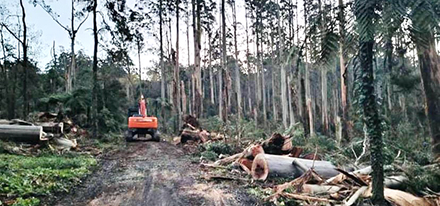It is coming up to 12 months since the big storm flattened quite a bit of the Wombat Forest and environs. Source: Weekly Times
What has happened since then? Well, after an interminable succession of chaotic fiddle-faddling around, the roads were finally cleared.
There was a multitude of those orange electronic signs, lollipop people, electronic traffic lights and sometimes a lollipop person sitting in a chair near an automatic traffic light with seemingly nothing better to do than to watch the transit of the sun.
I saw a 30-tonne excavator trying to pick up twigs and small branches while hi-vis vests stood and watched.
It was one of the most inefficient exercises I have seen.
It was also frustrating to see trees down on roadsides, including blackwood, with the potential to be turned into high-value product being cut up for firewood.
Maybe it would have been better to ask for real forest contractors with machinery appropriate for handling large trees and heads to do the job.
Processors, forwarders, and log trucks would have been procurable at short notice. Maybe a deal could have been struck; they get the sawlogs in return for aggregating the fall-down products (firewood etc) and the heads and trash ready for the mulchers.
The aggregation could, in many places have happened off the road rather than on the road as happened, intermittently closing the road for much longer periods.
What else has happened? Well, no visible activity. The fallen timber is still on the ground in the forest. A reasonable guesstimate might be about 700,000 cubic metres of millable timber product, plus fall down product such as firewood.
This amounts to 20 years’ full supply volume for all the small sawmills that used to operate out of the Wombat, before the activists and Government closed all the mills.
We now have a severe shortage of sawn timber, and dramatically escalating prices.
There are mills in the east of the state that are crying out for supply.
At the moment there is one mill down east laying off staff on full pay and closing for a time due to lack of supply. The future is bleak.
For the environmental health of the forest and to reduce the monumental wildfire potential we do need to salvage that timber and put it to a good, sustainable use.
Nearly 12 months for good sawlogs to lie on the ground without any salvage operation is unacceptable.
It is not best practice to leave millable timber on the ground, particularly through summer.
David Endacott has lived in the Daylesford region since the early 1950s and has served on government advisory committees dealing with public forest and public land management








